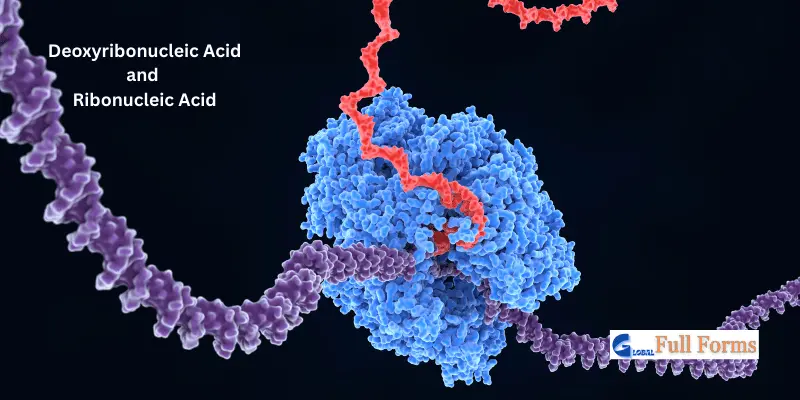DNA Full Form RNA in English and Hindi
Published: May 8, 2025
When we hear the term DNA full form RNA, we often think of complex science and genetics. But these two molecules are actually the building blocks of life!
So, what exactly do “DNA” and “RNA” stand for? Well, DNA stands for Deoxyribonucleic Acid, while RNA stands for Ribonucleic Acid.
Both of them are crucial in how living organisms grow, function, and reproduce.
In this article, we’ll dive into the DNA full form RNA, exploring what these terms mean and why they’re so important in the world of biology.
Whether you’re a student, a science enthusiast, or just curious about how life works on a molecular level, you’ll find the information here easy to understand!
What Does It Stand For?
DNA stands for Deoxyribonucleic Acid. The name itself gives us a clue about its structure and role. Let’s break it down:
Deoxyribo refers to deoxyribose, a sugar molecule that forms the backbone of DNA. This sugar is a modified form of ribose, which is found in RNA.
- The “deoxy” part indicates that it lacks one oxygen atom compared to ribose.
- Nucleic refers to the fact that DNA is a type of nucleic acid. Nucleic acids are large molecules made up of smaller units called nucleotides, which are the building blocks of DNA and RNA.
Acid indicates that DNA has acidic properties, which are important for its stability and function within cells.
RNA, on the other hand, stands for Ribonucleic Acid. It is similar to DNA but has a few key differences:
- Ribo refers to ribose, a sugar molecule that is part of RNA’s structure. Unlike DNA’s deoxyribose, ribose has one more oxygen atom, which is crucial for RNA’s different role in the cell.
- Nucleic indicates that RNA, like DNA, is a nucleic acid.
- Acid again points to RNA’s acidic nature.
While both DNA and RNA are made of nucleotides and play essential roles in cellular processes, DNA is primarily responsible for storing genetic information.
Whereas RNA plays a role in translating that information into proteins that help the body function.
DNA Full Form RNA in English

As we discussed earlier, DNA stands for Deoxyribonucleic Acid and RNA stands for Ribonucleic Acid.
These two terms are central to understanding how life works at a molecular level, and they play different but complementary roles in living organisms.
Let’s dive deeper into what the DNA full form RNA means in simple terms:
DNA (Deoxyribonucleic Acid)
DNA is often referred to as the blueprint of life because it contains the genetic instructions for the development, functioning, growth, and reproduction of all living organisms.
It is a long molecule made up of nucleotides—the building blocks of DNA.
Each nucleotide consists of three parts: a phosphate group, a sugar molecule (deoxyribose), and a nitrogenous base (adenine, thymine, cytosine, or guanine).
The sequence of these nitrogenous bases encodes genetic information.
Structure: DNA has a double helix structure, which looks like a twisted ladder.
The sides of the ladder are made of sugar and phosphate molecules, while the rungs are made of paired nitrogenous bases.
These bases pair in specific ways (adenine with thymine, and cytosine with guanine).
Function: DNA stores genetic information and is passed down from generation to generation. It’s the recipe for everything in your body, from physical traits to how your cells function.
It provides the instructions for building proteins, which are essential for cell structure and function.
RNA (Ribonucleic Acid)
RNA plays a key role in translating the genetic information stored in DNA into proteins.
Unlike DNA, RNA is typically single-stranded, and its sugar is ribose (which has one more oxygen atom than deoxyribose in DNA).
There are different types of RNA, but the most important ones are mRNA (messenger RNA), tRNA (transfer RNA), and rRNA (ribosomal RNA).
- Structure: RNA is single-stranded, and its nitrogenous bases are similar to DNA, except that uracil (U) replaces thymine. So, adenine pairs with uracil in RNA, and cytosine pairs with guanine.
- Function: RNA serves as a messenger between DNA and the protein-making machinery of the cell. mRNA carries the instructions from the DNA in the nucleus to the ribosomes in the cytoplasm, where proteins are made. RNA helps assemble amino acids into proteins, and rRNA forms the core of the ribosome’s structure and function.
In summary, DNA holds the genetic information (the code for life), and RNA helps decode that information and use it to build the proteins necessary for the body’s functions.
The process of converting DNA into RNA and then into proteins is called central dogma of molecular biology, and it’s essential for life as we know it.
DNA Full Form RNA in Hindi
जैसा कि हमने पहले चर्चा की थी, DNA का पूर्ण रूप डिऑक्सीरिबोन्यूक्लिक एसिड (Deoxyribonucleic Acid) है और RNA का पूर्ण रूप राइबोन्यूक्लिक एसिड (Ribonucleic Acid) है।
ये दोनों शब्द जीवन के आणविक स्तर पर कैसे काम करते हैं, इसे समझने के लिए महत्वपूर्ण हैं। इनका अलग-अलग लेकिन परस्पर संबंधित कार्य है।
आइए, विस्तार से समझते हैं कि DNA full form RNA का क्या मतलब है:
DNA (डिऑक्सीरिबोन्यूक्लिक एसिड)
DNA को अक्सर जीवन की रूपरेखा (Blueprint of life) कहा जाता है क्योंकि यह सभी जीवित प्राणियों के विकास, कार्य, वृद्धि और पुनरुत्पादन के लिए आनुवंशिक निर्देशों को संचित करता है।
यह एक लंबा अणु है जो न्यूक्लियोटाइड्स (nucleotides) से बना होता है—जो DNA के निर्माण खंड होते हैं। प्रत्येक न्यूक्लियोटाइड तीन हिस्सों से बना होता है: एक फॉस्फेट समूह, एक शुगर अणु (डिऑक्सीरिबोज) और एक नाइट्रोजनयुक्त आधार (एडेनिन, थाइमिन, साइटोसिन, या ग्वानिन)। इन नाइट्रोजनयुक्त आधारों का अनुक्रम आनुवंशिक जानकारी को कोड करता है।
- संरचना: DNA की संरचना डबल हेलिक्स (Double Helix) जैसी होती है, जो एक घुंघराले सीढ़ी के समान दिखती है। सीढ़ी की बाजू शुगर और फॉस्फेट अणुओं से बनी होती हैं, जबकि सीढ़ी के रोटे नाइट्रोजनयुक्त आधारों से बने होते हैं। ये आधार विशेष तरीके से जोड़ते हैं (एडेनिन-थाइमिन, साइटोसिन-ग्वानिन के साथ)।
- कार्य: DNA आनुवंशिक जानकारी को संचित करता है और इसे पीढ़ी दर पीढ़ी पारित करता है। यह आपके शरीर में हर चीज़ का नुस्खा है, जैसे कि शारीरिक लक्षण और आपकी कोशिकाओं का कार्य। यह प्रोटीन बनाने के लिए निर्देश प्रदान करता है, जो कोशिकाओं की संरचना और कार्य के लिए आवश्यक होते हैं।
RNA (राइबोन्यूक्लिक एसिड)
RNA का मुख्य कार्य DNA में संग्रहीत आनुवंशिक जानकारी को प्रोटीन में परिवर्तित करने में मदद करना है।
DNA के मुकाबले RNA आम तौर पर सिंगल-स्ट्रैंडेड (single-stranded) होता है, और इसमें शुगर राइबोज होता है (जो DNA में डिऑक्सीरिबोज से एक ऑक्सीजन अणु अधिक होता है)।
RNA के विभिन्न प्रकार होते हैं, लेकिन सबसे महत्वपूर्ण प्रकार हैं mRNA (messenger RNA), tRNA (transfer RNA), और rRNA (ribosomal RNA)।
- संरचना: RNA सिंगल-स्ट्रैंडेड होता है, और इसके नाइट्रोजनयुक्त आधार DNA के समान होते हैं, सिवाय इसके कि इसमें यूरेसिल (U) थाइमिन (T) के स्थान पर होता है। इस प्रकार, RNA में एडेनिन और यूरेसिल एक साथ जुड़ते हैं, जबकि साइटोसिन और ग्वानिन एक साथ जुड़ते हैं।
- कार्य: RNA DNA से प्रोटीन बनाने के निर्देश लेकर कोशिका के राइबोसोम (ribosome) तक पहुँचाता है। mRNA DNA से सूचना लेकर राइबोसोम में जाती है, जहाँ प्रोटीन बनते हैं। tRNA अमीनो एसिड को प्रोटीन में जोड़ने में मदद करता है, और rRNA राइबोसोम की संरचना और कार्य में अहम भूमिका निभाता है।
सारांश में, DNA जीवन के लिए आनुवंशिक जानकारी (जीवन का कोड) संचित करता है, और RNA उस जानकारी को प्रोटीन बनाने के लिए प्रयोग करता है। DNA से RNA और फिर प्रोटीन में बदलने की प्रक्रिया को केंद्रीय सिद्धांत (central dogma of molecular biology) कहा जाता है, और यह जीवन के लिए अत्यंत आवश्यक है।
FAQs
The full form of DNA is Deoxyribonucleic Acid. It is the molecule that carries the genetic instructions for life and is found in the cells of all living organisms.
The full form of RNA is Ribonucleic Acid. RNA is a molecule that plays an essential role in protein synthesis by carrying genetic information from DNA to the cell’s ribosomes.
The main differences between DNA and RNA are:
DNA is double-stranded, whereas RNA is single-stranded.
DNA contains the sugar deoxyribose, while RNA contains ribose.
DNA stores genetic information, while RNA helps translate this information into proteins.
DNA uses thymine (T) as one of its nitrogenous bases, whereas RNA uses uracil (U) instead of thymine.
RNA is important because it helps in the process of translating the genetic code stored in DNA into proteins. These proteins are vital for the structure and function of the body. RNA acts as a messenger between DNA and the ribosomes, where proteins are made.
Yes, DNA and RNA work together in the process of gene expression. DNA holds the genetic code, and RNA is responsible for carrying that code to the ribosomes where it is used to synthesize proteins. This interaction is essential for the growth, functioning, and reproduction of cells.
Conclusion
In conclusion, both DNA (Deoxyribonucleic Acid) and RNA (Ribonucleic Acid) are vital molecules that play key roles in the life of every organism.
DNA acts as the blueprint, storing all the genetic information needed for growth, development, and reproduction.
RNA, on the other hand, helps decode and carry out the instructions from DNA to produce proteins, which are essential for the body’s functions.
Understanding the DNA full form RNA and how they work together is fundamental to grasping how life operates at a molecular level.
Whether you’re studying biology or just curious about how cells function, knowing about DNA and RNA helps you appreciate the complexity of life itself.
Extra Points
- DNA is the hereditary material: DNA is passed from parents to offspring, which is why you inherit traits like eye color or hair type from your parents. It’s the reason why family members often look similar to each other!
- RNA can be found in different types: There are several types of RNA, each with a specific job. For example, mRNA (messenger RNA) carries instructions from DNA to the ribosomes, tRNA (transfer RNA) helps assemble proteins, and rRNA (ribosomal RNA) forms part of the ribosome, the protein factory of the cell.
- DNA is stable, but RNA is more flexible: DNA is designed to be a stable storage of genetic information, while RNA is temporary. This flexibility allows RNA to quickly carry out tasks, like making proteins, and then break down once its job is done.
- Both DNA and RNA are made of nucleotides: Nucleotides are the building blocks of both DNA and RNA. They are made up of a sugar, a phosphate group, and a nitrogenous base (like adenine, thymine, cytosine, guanine in DNA, and uracil in RNA).
- DNA replication: Before a cell divides, it makes a copy of its DNA through a process called replication. This ensures that each new cell has the exact same genetic information as the original cell.
- RNA’s role in viruses: Some viruses, like the flu or COVID-19 virus, use RNA as their genetic material instead of DNA. This is why treatments for viral infections focus on targeting RNA.

- Be Respectful
- Stay Relevant
- Stay Positive
- True Feedback
- Encourage Discussion
- Avoid Spamming
- No Fake News
- Don't Copy-Paste
- No Personal Attacks

- Be Respectful
- Stay Relevant
- Stay Positive
- True Feedback
- Encourage Discussion
- Avoid Spamming
- No Fake News
- Don't Copy-Paste
- No Personal Attacks





